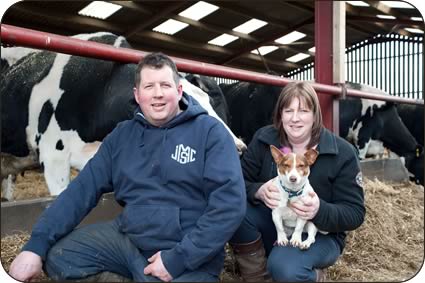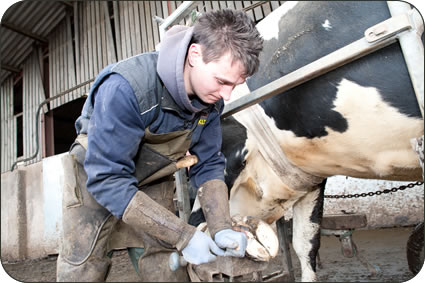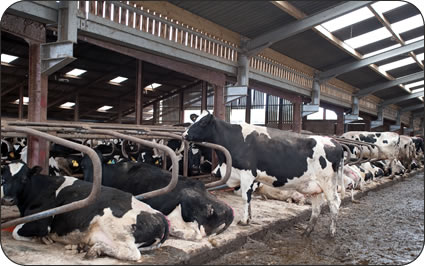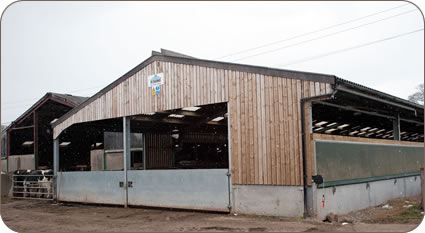Jennifer MacKenzie is an agricultural photo journalist with almost 30 year's experience. Operating from her base in Cumbria, Jennifer undertakes mainly industry-related freelance writing and photography.
Dairy Monitor Farm Results
Four years on from embarking on an expansion plan to double dairy cow numbers
at Hesket Farm, Dacre, on the edge of the Lake District, Matt and Sue Bland
have achieved most of their objectives while at the same time have maintained
milk yields.
The couple who farm 277 acres of mixed soil type, running from 600ft to 920ft above sea level, one of the few remaining dairy units in the Lake District National Park, became one of six RDPE Livestock Northwest Programme monitor farms in Cumbria, Lancashire and Cheshire in 2009 and they have had input from both experts and farmers on how to improve their farm’s profitability.
The programme comes to a close in July, and Matt and Sue have expanded the herd from 150 to 300 cows by buying in mostly fresh heifers from France, Germany and Denmark.
 |
Matt and Sue Bland |
As part of the programme, they set business and performance targets with
Promar’s Paul Henderson, vet Victor Oudhuis of Paragon and SAC senior
dairy and nutrition consultant Jimmy Goldie, based at Crichton Royal, Dumfries.
Key areas targeted have included making better use of home grown grazed
grass, conserved grass and wholecrop which has reduced concentrate use
without compromising yield or fertility.
Managing herd health, paying particular attention to transition cows and
cow mobility, has also been a major focus.
The exercise has also given Matt and Sue added confidence to manage and
expand the business and to employ a full time member of staff, cowman Marcus
Fox.
 |
Marcus Fox carrying out foot trimming |
Prior to joining the programme, the Blands installed a new parlour with
computerised feeding system and shedding gates. A new dry cow building
was also erected and more recently the cubicle housing was extended with
a new building.
The Blands decided to sell off their youngstock to help fund the expansion
and maximise acreage.
Jimmy Goldie said Matt and Sue had managed their expansion plan well. “It
will always take longer than you anticipate. Matt and Sue with the help
of Promar devised a business plan and they have stuck to it with some modifications
as it progressed,” he said.
“It’s a difficult decision when expanding as to what comes
first - a new parlour or cows - but avoid overstocking a building. I believe
a building has a ‘capacity for milk’ and this has been proven
recently when producers have been culling cows because of shortages of
feed but their milk production has not been reduced.”
Matt and Sue have maintained yields at around 8,200 litres over the last
two years, despite buying in cows for the flying herd.
Milk from forage has increased dramatically over the period rising from
1,868 litres a cow in February 2011 to 2,677 litres in February this year.
One
of the first meetings held at Hesket Farm in 2010 looked at getting more
from grass. New paddocks have since been created and smaller grazing areas
allow the cows to be moved more regularly. Grass is also monitored by a
plate meter.
 |
cows in the new cubicle housing |
Cows are now split into four groups by yield and fed accordingly. Dry cows
are now fed a dedicated ration form the Keenan feeder. Early lactation
cows and dry cows are not grazed - only low yielders are turned out.
Spending time and money on transition cows and cow mobility under the guidance
of Victor Oudhuis has helped to improve the cows’ ability to graze
and utilise feed better.
Victor scores the cows every three months as part of DairyCo’s healthy
feet programme. Managing herd health through the expansion has been a key
achievement.
As a result, more than half the herd now has the highest mobility score
of 0-1 with only a few still at score 3.
Management of transition cows has also been a target. The new dry cow building
at Hesket Farm now needs further expansion to house the 60 dry cows in
the herd of 300, allowing nine to 12 square metres of space per cow and
a feed space of 70cm per cow.
Victor said the target calving index was 390 - significant reductions have
been made since 2011 when was running at 436 days and it is now at 407
days. A simple assessment of which transition cows were not doing well
was to monitor which were not eating, he said.
Significant improvements had also been made in mastitis by adopting a proper
drying off protocol. Improved parlour hygiene had also reduced environmental
mastitis to keep cell counts running at below 200,000.
The herd is vaccinated for Leptospirosis, BVD and IBR and, despite importing
cattle to increase herd numbers, disease has not been an issue.
The Blands’ ultimate aim is to consolidate the herd to achieve optimum
production, increase the slurry storage and then invest in cow tracks.
In the long term, the aim is to expand to a 400 cow herd, with an additional
100 cubicles and loose boxes and expand the transition housing.
With experience over the expansion period so far, Matt said: “If
we were starting again, we would increase cow numbers in one go rather
than staging it over an 18 month period. This would aid cash flow by increasing
income and reducing some of the financial pressures sooner. Managing cash
flow has been one of the biggest hurdles to overcome.
The monitor farm programme has been delivered in Cumbria by Cumbria Farmer
Network, with Myerscough and Reaseheath colleges managing the farms in
Lancashire and Cheshire respectively.
 |
new cubicle housing |
Kendal milk producer David Martin has gained invaluable knowledge from
the farmer meetings he has attended and, in particular, the DairyCo Milkbench+
meetings.
“I have been using the benchmarking system for three years and receiving
the data to compare the farm’s performance,” said David, who
has been expanding the pedigree Holstein herd at Lords Plain, Levens, to
225 cows over the last couple of years.
“Since I have been attending the meetings over the last two years
organised by the Farmer Network it has been much easier to see my
business’s strengths and weaknesses in discussion with other producers.
“As a result, I have looked closely at variable costs and improved
herd profitability.”
It is hoped that the Milkbench+ producer meetings can continue after the
programme ends.
Diets
High Yielders and Transition Cows:
27kg silage
1kg high protein molasses
2kg maize distillers
6kg blend
0.20 megalac
Low Yielders:
27kg silage - silage is second cut and 43% dry matter
1kg molasses
2kg maize distillers
3 .5 kg blend
Dry cows:
1kg molasses
5g straw
0.75 maize distillers
2.5 kg blend
10.27 kg silage
| Goals | Key performance measure | Feb 2011 | Feb 2012 | Feb 2013 |
| Improve mobility scores | Mobility score 0-1 2 and 3 (%) | 48 20 28 | 78 16 7 | 66 28 6 |
| Increase milk yield | Annual milk yield litres/cow | 8,100 | 8,259 | 8,200 |
| Increase milk from forage | Milk per cow from forage | 1,868 | 1,521 | 2,677 |
| Reduce calving index | Average days between calvings/cow | 436 | 416 | 407 |

